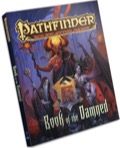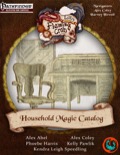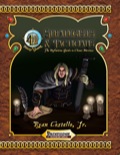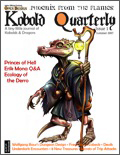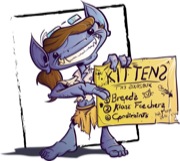Sign in to create or edit a product review. Wickedly Evil. Brilliantly Wicked.Visually this book is great. The chapter 1 opener alone is amazing. But what do we get in terms of actual content here? What makes this book worth your hard-earned gaming dollar? Well, let me break it down for you. The first chapter is 124 pages of fiendish divinities, the vast majority of the Lords, Princes, Archdevils, Ranas, Harbingers, Demagogues, and whatever other categories of quasi-divine fiends that have been mentioned ever since the first Pathfinder Bestiary. All of them at the very least getting a few lines of description, an Obedience, and spell-like abilities for their Boons. The major players in the Abyss, Abaddon, and Hell get fully laid out cult details (domains, favored weapons, and whatnot) plus Evangelist, Exalted, and Sentinel boons as well as an Obedience. Chapter 2 has 24 pages on Fiendish Realms, whether in Hell, Abaddon, the Abyss, elsewhere across the planes, or even within the demiplane linked to the Book of the Damned itself. (Yes, the tome you end up perusing might link the unwary to a netherrealm of fiendish darkness - reader beware!) Chapter 3 brings us 36 pages on Fiendish Influences, ie, "crunch", feats, spells, rituals, magic items, artifacts, prestige classes, and six pages devoted just to Infernal Contracts, selling a soul in a buyer's market. Chapter 4 unveils 36 pages for the Fiendish Bestiary, including discussions on summoning various creatures from the nether realms, focusing on demons, daemons, and devils, as well as a catch-all section for everything else, and then a new type of fiend for every existing fiendish subtype, from asuras to sahkils. Finally, the Appendix includes 28 pages of excerpts supposedly from the Book of the Damned itself, blasphemous rantings of a fallen angel who saw too much, for too long. Lo, beware you who would read it too. lest ye go mad as well. For thine reviewer, however, 'tis but too late. Finishing up things we get a 1-page index, the OGL on 1 page, and finally a 1-page ad for the Starfinder Alien Archive. Any "missing" pages from the 288-page total are from chapter opening spreads (the one for Chapter 1 is gorgeous) or from the initial section detailing the dangers of the Book of the Damned itself, as an artifact your PCs or NPC villains might interact with. This is a massive book, but if you want to fill a campaign with heavy detail about scores of fiendish cults then look no further. If you want to delve deeper into the monstrous evils of the Lower Planes then look no further. If you want to know just what those things are that go "bump" in the night around your PCs' camps, then look no further. In all seriousness, though, this is legitimately one of the best books Paizo has put out for Pathfinder. If you play in the Golarion setting, or if your setting uses fiendish creatures of any kind, it is absolutely worth your money, even if just the $9.99 for a PDF. This review is based upon a free copy via Flaming Crab Games's very generous "free copy to the first 10 posters" initiative. Presented as an artifact from a crashed warship originating on an alternate universe magical Earth, this catalog from, oh, 1918 or so, aims to capture the feeling of old turn-of-the-century Sears catalogs, and for old school RPG gamers, the oh-so-fondly remembered 2e Forgotten Realms accessory known as Aurora's Whole Realms Catalogue (which was also trying to capture the feeling of those old Sears catalogs.) There's 28 pages worth of items, spells, and alchemical items to be had here, all of which are of minor use outside of the home at best. (It's a 39 page PDF in total, but 28 pages of actual items, plus cover, credits, an intro, lists of contents with prices, the OGL and a couple of other decorative pages.) A few of the alchemical items have their uses for adventurers, but mostly this book's contents are for decoration and an attempt at verisimilitude for a magical civilization. Nothing is egregiously anachronistic, well, except for the "Room Baa," a mechanical sheep atop a floating magical disk that roams the home sucking up small pieces of debris and depositing them into an extradimensional space. That one just triggers my "too silly even for a game" sense. The groan-inducing silliness of the Room Baa aside, there are also some things that feel a bit oddly balanced, power- or cost-wise, and it feels like some of the alchemical items might work better as magic (or vice-versa), but these are minor quibbles at best. Overall it is a well done product, and does a good job of recapturing the old-school feeling of old-school gaming, and really old school catalogs. (The "Room Baa", though, that pun is just so terrible it's why my review settled down to just 4 stars. Bad pun. Bad.) So what are you getting with this product, an attempt to revive the types of things you'd see in an old April issue of Dragon Magazine? Well, you get a 17 page PDF (cover, 14 pages of actual content, credits, and OGL) that ranges from the pointlessly silly to the actually quite ingenius and *very* useful for a Golarion game. * Half a dozen comedic traits. * Comrade (Commoner). Basically they have a kind of inverted Leadership where they get stronger the more allies ("buddies") they have around them. They learn buddies' feats, class abilities, skill unlocks, etc., and they learn to become quite proficient indeed with Aid Another. * Derelict (Paladin). Meh. Why bother? Evil's just going to triumph in the end. I can't even risk bringing down a celestial spirit by having them serve me or my weapon, but my own personal crushing despair, now *that* I can use for a weapon. * Gnostic Atheist (Cleric). This is the single biggest and best thing in the book, and what inspired me to write this review. Sounds to me like much of the Rahadoumi world-view all in one archetype. No domains, no domain spell slots, no favored weapon, but they do get a sort of "Antimagic" domain and bonus spell slot per level per day. They become very skilled at counterspelling any divine spell, and they gain SR against any divine spell, or the spell-like abilities of outsiders. Finally, and this is where they might start to make very good BBEG's, or at least big rivals, their intense denial of divinity starts to spread out into an aura around themselves in an ever-widening radius, applying their anti-divine SR to everyone else, forcing any divine caster trying to cast a spell to overcome their SR just to function at all. Yeah, this archetype has Rahadoum written all over it. * Mad Scientist (Alchemist). Do you want to ditch alchemical mixtures and replace them with all sorts of crazy steampunk-esque gadgets while risking your lab blowing up if you mistranslate a forumla? Here's your class archetype. SCIENCE! * Prankster (Bard). This is the truly comedic option in the book. The other archetypes might be funny sounding or have a comedic air about them, but this one is all-out comedy. Do you want to Heckle opponents that fail attack rolls or saves, be able to conjure Prismatic Pies out of nowhere, or hit them with the literal Killing Joke? (The mechanics also seem to have picked up a bit from the design process behind RGG's Talented Bard which just released recently, so there's no set progression on Comedic Antics, just level pre-requisites to meet.) * Comedic Feats. These seem to keep to the trend of "heavily themed, but actually rather useful when you think about it." They also have that RGG/4 Horsemen level of "is this a little overpowered, or just about right?" I like the higher level of power, but I can see why some would say it's a bit too much.
All in all, there's actually quite a bit here for a $3.99 PDF. At first glance it all seems like silly jokes, but when you think about some of it, at least mechanically, it starts to seem less and less silly, and more like "You know, I can really use that in my next game." And that Cleric archetype just screams Rahadoum to me louder and clearer than almost anything else I think I've seen. I've never really been able to quite get how that country could survive in Golarion with all of the obvious, powerful divine casters and outsiders around. After seeing this archetype, though, I can finally get a good idea of just how enough of them really could kick out the servants of the gods from an entire country. Strategists and Tacticians is a new book by Ryan Costello Jr. and published by 4 Winds Fantasy Gaming, dealing with combat and strategy, including new options for maneuvers. First off, I do want to start this review by noting a big improvement in this book over some of 4WFG's past books - the internal art is (other than a reused piece or two) finally what I expect to get out of a PDF that costs this much. It may all be B&W, but it's *well-done* black and white. The cover is a slight step down from their previous releases like the one on their overall excellent release Luven Lightfinger's Gear & Treasure Shop but it's still a decent looking piece. Chapter 1 - Strategic Characters (18 pages)
Chapter 2 - Prestige Classes (27 pages)
Chapter 3 - Options (24 pages)
Chapter 4 - Tactical Maneuvers (6 pages)
Chapter 5 - Flynn Dielle
Appendix - Prosthetics (7 pages)
All in all, this is an interesting book with many good ideas for combat, even with its problems. A good buy. Dark_Mistress's review goes into much more detail than mine will, but she said one thing that I agree with whole-heartedly - I really regret not buying the print release of this wonderful book, probably for the first time in years of buying almost exclusively PDFs. Not being familiar with Everything and a 10' Pole, there's really only one book for me to compare this excellent new release to, an almost-twenty year old 2e release by the name of Aurora's Whole Realms Catalogue. Any older gamer will immediately perk up at mention of that classic, and they absolutely should. This is a excellent book, and any GM who's wanting a more detailed approach to their PCs' gear beyond "We go back into town and buy rations" needs to check this one out. Wonderful detail, even extravagant by some measures, but so familiar when one compares it to the classic Aurora's, and a welcome return to Pathfinder-era gaming. The only real issue I have with the book is some of the art choices, particularly in chapter 1. The weapons and armor art looks more to me like the rough sketch of an idea that should be sent out to the artist as something to work from and improve, not finished, publishable work, to be honest. And I know the book has a lot of 2e nostalgia going for it, but Larry Elmore's style never felt "3e" to me at all, so to me it feels even more out of place for NPC portraits in a Pathfinder release. The (relatively minor) art issues aside, this is a great book. Don't hesitate to pick it up if you want a more detailed, realistic approach to PC gear, or even just as a nicely detailed gear shop and inn/tavern for your PCs to make their home away from home. EDIT: If you haven't noticed from the commentary on this product recently, there's now a 2nd edition of the PDF featuring new and improved art for the armor and weapons. You can ignore what I said above in my initial review about any art issues. They've all been fixed. This is now exactly what I hoped it would be, the best 3rd party equipment guide for Pathfinder, period. At first glance when I read through this PDF, I was underwhelmed. It seemed like a mediocre little book of modified core classes, just little meaningless tweaks to abilities here and there, swap this for that, blend these two classes together, etc. Then I sat down and really worked with the material here. The eleven new classes, (or about 22 cents a class) are all non-magical, with the partial exception of some of the Scholar's abilities, and those are only if they are chosen, so this book makes for a great counter to those who feel the Advanced Player's Guide will go overboard with caster classes. I can't give it the in-depth review it really needs here, because the genius in the classes only comes out with time spent working with them, statting out characters, seeing how they compare to core classes, and recognizing just how the changes all counter-balance one another and the new options they bring to the gaming table. And did I mention it's only 2.39, people? Half the price of a latte, in other words. It's certainly worth 239 of your gaming pennies. I can't say enough about how useful this little gem is. Seriously, don't listen to the complaints, unless you want to run initiative out in the open or you have access to a 24"x36" or bigger marker board. This little gem is BRILLIANT. Every single d20/OGL/GSL gamesmaster needs one. The first issue from Wolfgang Baur's Kobold Quarterly is a very interesting new offering in the D&D/d20 world. It has a good mix of articles, both fluffy and crunchy (although its comics are a bit flat, Stan! should lay off the old April issue of Dragon-style puns), and it shows a lot of promise for what it can turn into in the future. Jiro the Grey Wyrm (the cover model and apparent mascot of the KQ) has a few things to work on here and there, true (editing and typo issues, but then again if we complain about that, we'd have to condemn just about every book WotC's released for the last five years), but the promise shown in articles like the continuation of the Ecology series (Derro) and the first of the Princes of Hell (Titivillus, the CR 24 prince of scribes) makes a subscription well worth any D&Der's $16, or the $6 for this first issue. It's really a 4.5 star product, 4 for execution and 5 for promise of the future. Don't hesitate at all, folks. If you miss the Dragon, give a certain little Kobold a try. You won't regret it.
|
Sign in to create or edit a product review.
|





